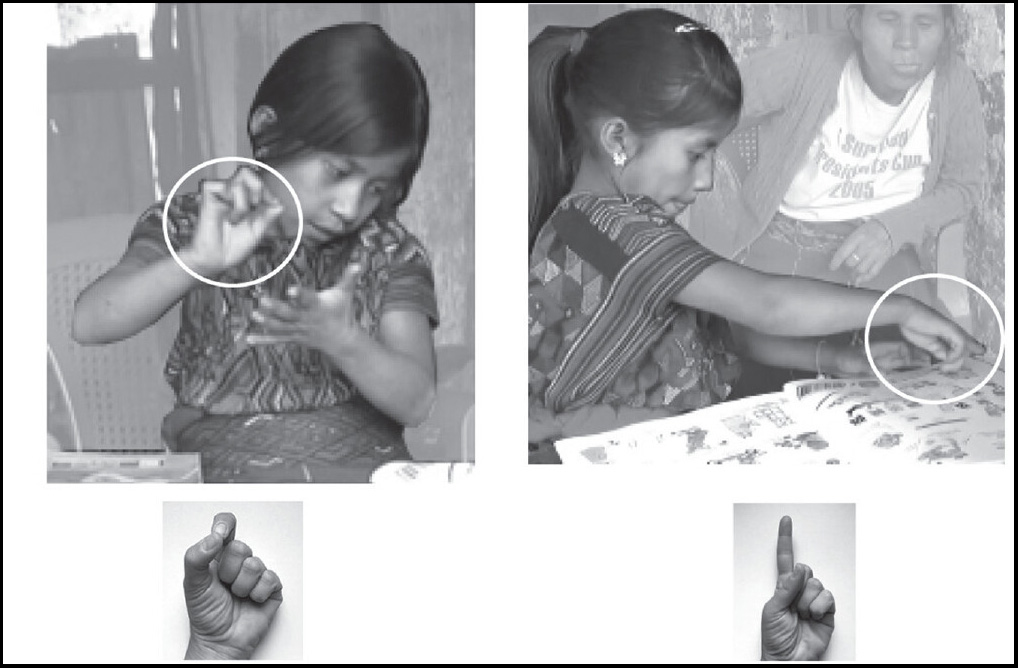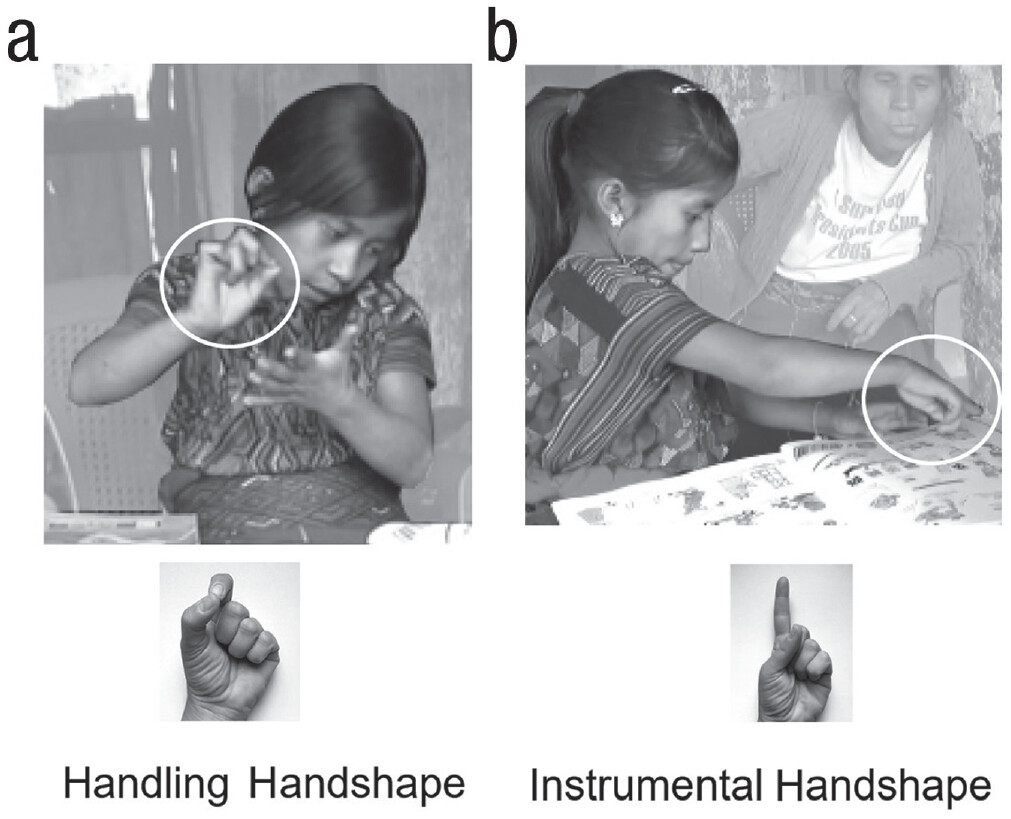The Self-Taught Vocabulary of Homesigning Deaf Children Supports Universal Constraints on Language

Deaf homesigner in Guatemala, © The Author(s) 2023.
Languages may seem different on an instinctual level—“hello,” for example, does not sound like “ni hao.” But the work of many psychological scientists suggests that the thousands of languages spoken throughout the world draw on many of the same fundamental linguistic abilities and reflect universal aspects of how humans categorize events. Some aspects of language may also be universal to people who create their own sign languages, according to new research in Psychological Science. The researchers compared how young homesigners—deaf children without access to an established sign language—and English-, Spanish-, and Chinese-speaking adults describe the use of tools such as paintbrushes and knives.
“We found broad similarities across these groups, indicating ways of thinking about the world—and describing the world through language—that are common to all people,” wrote researchers Lilia Rissman, Laura Horton (University of Wisconsin-Madison), and APS William James Award recipient and former APS President Susan Goldin-Meadow (The University of Chicago). “These results help us understand which aspects of our thinking and communication are a product of being human rather than a product of our particular cultures and experiences.”
Most children learn to speak their first language through immersion in the linguistic culture around them, but this is not the case for deaf children without access to an established sign language.
”[Deaf homesigners] give us a unique window into this question of ‘are there universals for how people use language to talk about ideas,’” said Rissman in an interview. That’s “because homesigners are creating language from the ground up through their gestures; they aren’t learning an established linguistic system from a community.” Rissman and colleagues dug deeper into the universal constraints on language by comparing the tool-related language use of 43 hearing adult speakers of Chinese, Spanish, and English and 10 deaf homesigners ages 3 to 11 from Guatemala, Nicaragua, the United States, Taiwan, and Turkey.
Because there are relatively few children with these unique circumstances, it took Rissman and colleagues several decades to collect data from the homesigning children. Each child was filmed during one to four sessions while looking at a picture book with a researcher, family member, or friend and being asked to describe what was happening in different scenes using their own version of homesign. The illustrations included images of tool events, such as a pig painting and a rabbit cutting fruit, as well as stand-alone images of tools like paintbrushes and knives that were not being used.

Upon reviewing the footage, the researchers coded the homesign for each tool-related action or object according to whether it was an instrumental sign that reflected the shape of the tool, a handling sign that reflected the shape of the hand holding the tool, or an ambiguous sign.
A group of 24 online participants were also tasked with judging how well, on a scale of 1 to 5, the instrumental signs most commonly used by the deaf children to describe each event reflected the shape of the tool being used. For events that the children described with handling signs, the participants were asked to rate instrumental signs from various global sign languages.
The English-, Spanish-, and Chinese-speaking adults completed a similar task online in which they were asked to describe what was happening in the tool-event images and, for the images of stand-alone tools, to indicate the action most commonly associated with each tool. A separate set of online reviewers fluent in each language judged the verbs the participants used in their descriptions to determine if the verbs used highlighted the tool or the action in question. For example, 97% of English-speaking online respondents perceived “cut” as tool-oriented because of its close association with tools like scissors and knives. But just 3% of online reviewers had this perception of the more general verb “make,” which any number of tools (or none at all) can do.
Overall, Rissman and colleagues found that when online reviewers perceived the verbs that English, Spanish, and Chinese-speaking participants used to describe an event as more tool-oriented, the homesigning children were also likelier to use instrumental signs to describe the same actions.
“This correspondence suggests universal constraints on the interface between conceptual event knowledge and language because we observed this common pattern across children and adults, across different cultures, and across individuals who had learned a conventional language from birth and individuals who had not,” the researchers wrote.
On the other hand, when describing stand-alone images of tools, hearing participants’ use of tool-oriented verbs did not predict deaf children’s use of instrumental signs. This suggests that these findings are specific to universal constraints on how humans describe tool-use events, not tools in general, Rissman and colleagues wrote.
Similarities in how people describe tool-use events may reflect the extent to which a tool is perceived to “mold” the object it is being used on, such as when a shovel leaves a similarly shaped indent in the ground, the researchers suggested.
In future work, Rissman would like to explore the extent to which universal constraints on how people describe tool use may influence the perception and recall of those events.
Feedback on this article? Email [email protected] or login to comment. Interested in writing for us? Read our contributor guidelines.
Reference
Rissman, L., Horton, L., & Goldin-Meadow, S. (2023). Universal constraints on linguistic event categories: A cross-cultural study of child homesign. Psychological Science. https://doi.org/10.1177/09567976221140328
Related content we think you’ll enjoy
-

How Our Bodies Do — and Don’t — Shape Our Minds
Moving our legs, hands, and other body parts shape our lives as we traverse our environments. Jessica Witt, Amy Cuddy, Susan Wagner Cook, and Ted Supalla share their research investigating how our bodies influence the way we see, feel, learn, and communicate.
-

The Littlest Linguists: New Research on Language Development
New research on language acquisition, bilingualism, and speech perception.
-

Hearing
Learn how the human brain influences what our ears register – and what they don’t.



APS regularly opens certain online articles for discussion on our website. Effective February 2021, you must be a logged-in APS member to post comments. By posting a comment, you agree to our Community Guidelines and the display of your profile information, including your name and affiliation. Any opinions, findings, conclusions, or recommendations present in article comments are those of the writers and do not necessarily reflect the views of APS or the article’s author. For more information, please see our Community Guidelines.
Please login with your APS account to comment.